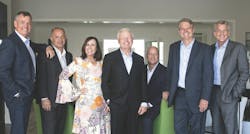2019 Builder of the Year: The New Home Company
When Larry Webb left John Laing Homes in 2008, he had a year-long noncompete clause in which to contemplate his future, and his legacy, in home building.
Under his leadership, Laing had grown from a two-market operation in 1995 to being the second-largest private builder in the country a decade later, but its story did not end well. In 2006, a Dubai-based real estate developer bought the company for $1.05 billion, promising to invest in even more aggressive growth; two years later, on the cusp of the Great Recession, the developer stopped funding its shiny new object. Laing foundered as the downturn worsened, filing for Chapter 11 bankruptcy and eventual liquidation in 2009. Though Webb had left the company a year earlier, it was not how he wanted his home building story to end.
Webb knew—after 30-plus years in the housing industry working in and leading such companies as Kaufman & Broad (now KB Home) and Greystone Homes before landing at Laing—that home building operations are “silos stuffed with white guys” who work hard but not collaboratively.
So he started a new company from scratch; no old-school legacy culture to remake, no overseas owners to placate, no nothing, really. When The New Home Company opened its doors in mid-2009, it was almost entirely in name only, with $60 million in the bank from equal investments by Webb and three other former Laing executives—Tom Redwitz, Wayne Stelmar, and Joseph Davis—and employees willing to work for almost (and sometimes literally) nothing while the startup found its footing.
Fast-forward to today, where The New Home Company ranks 28th in Professional Builder’s 2019 Housing Giants list, with 1,244 closings across three divisions in two states and $806 million in total revenue. Since going public in 2014 with an IPO that raised $86 million to buy land and compete with nationals in the uber-competitive Bay Area and Southern California (and since then, Phoenix) markets, the company’s annual revenue from home sales and fee building grew from $149.7 million to $667.6 million in 2018.
But those numbers and others, impressive as they are, aren’t what earned The New Home Company our 2019 Builder of the Year accolade. Instead, that distinction recognizes and applauds a culture that enables the company to be smart, nimble, and profitable thanks to a deliberate diversity among its people, processes, and product—a model sure to endure after Webb handed the CEO reins to president and former COO Leonard Miller this past July.
It’s a model of collaboration Webb has nurtured since entering the industry in 1987; a model that dates back to when he taught high school in Stockbridge, Mass., and coached youth soccer and basketball—one that’s all about team. And, for Webb, building houses is the ultimate team-building exercise: Get the right people, he says, and get them to work together.
The New Home Company Culture in Action
Larry Webb has two mantras: “People matter,” and “Do the right thing.”
Outsiders may dismiss those philosophies as cliché or quaint, but why else would former Laing employees work a couple of months without pay for a startup during the recession? Or a former Laing construction manager jump from being the VP of operations for another builder to “drink the Larry Webb Kool-Aid” for significantly less money? Even subcontractors that lost big in Laing’s liquidation leapt at the chance to work for Webb and the new company, and many remain among the builder’s core group of trade partners a decade later.
“To have the opportunity to start something from scratch without the carryover, without the baggage, and with founders who use those guiding principles, was a great way to start,” says Mark Kawanami, one of the first four New Home employees and now its SVP of operations.
Webb and others on his skeleton crew in 2009 had been in companies where departments not only didn’t work together, they didn’t like one another. He saw managers emasculate employees and trades, and he admits to giving a pass to such behavior because numbers were all that mattered, and they were being met.
That ended (or didn’t get a chance to start) at The New Home Company, an apt moniker for Webb’s vision of a collaborative culture. “I want employees in all departments to be meeting all the time and helping one another,” he says. “What’s always been a challenge in our industry is for people to stand in each other’s shoes with empathy and say ‘I need you and you need me.’”
A Company Where People Matter
David Donaldson’s first contact with New Home was as an on-site tech support consultant. After two weeks, he knew he wanted to be an employee because there was something different about the company’s leadership and management.
“They really encourage us,” says Donaldson, now the in-house client services and support manager (read: IT systems guru). “They show us respect, not only by giving us space to say we have new ideas for doing things and to prove it; they show us value.”
Donaldson was one of several younger employees, many of whom had little or no direct housing experience, hired after the company went public. It’s a tight-knit group that, along with an intentional effort to promote more women into senior management roles (see “Leading Women,” below), has been instrumental in helping New Home break down silos and barriers and improve communication across departments.
With neither formal say-so nor resistance from above, staff exchange ideas and problem-solve among one another and their departments, and with senior managers in hallway conversations, to rethink and redesign processes that streamline operations across the board. Upper management’s willingness to listen, tweak, and accept ideas, employees say, has emboldened staff to take on more responsibilities.
Case in point: Empowered employees, from project managers Holly Slevcove and Matthew Blain to land acquisition manager John Neff and director-level finance experts Rob Irwin and Ryan Christensen, found design review committee (DRC) proceedings unwieldy because participants were generally unprepared to push plans to the field, causing time-consuming follow-ups and costly delays.
Now, Slevcove, Blain, and other project managers send DRC meeting notices with complete sets of plans and comments from third-party consultants attached, as well as an explanation of how decisions will affect a project’s schedule and budget. That up-front work allows participants to review the material and prepare comments, which has reduced meeting duration.
And, each DRC session now concludes with a brief wrap-up of what was agreed upon, next steps, who’s accountable for them, and a detailed summary emailed to attendees and relevant parties.
Another example: When Neff came on board, he was handed a 30-page template for assessing land feasibility that COO Miller used at a previous company. Rather than blindly follow the template, Neff boiled it down to three pages that were equally effective, but more efficient. “I just put it together on my own, and senior managers looked at it and just said ‘OK, this is fine.’”
Irwin and Christensen recall a similar story, distilling a cumbersome monthly process to gauge expenses against budget into what is now internally called the Budget Master, a customized Excel-based software program Christensen created to produce better data faster, enabling more informed and nimble strategic decisions.
The Budget Master harks back to the duo’s first days at the company when it was still trying to formalize policies and procedures. “We’d say, ‘I see a need for this; I’ll work on this today,’” recalls Irwin, now the company’s director of financial planning and analysis. “When we’re trying to change things, Ryan [now director of finance] and I always say the results will speak for themselves.”
“We probably created 50 reports that nobody ever looked at, but we also created 20 that now run our business,” Irwin says. “The culture that leadership set up really paved the path to allow us the opportunities that we’ve had over the last few years.”
Even Miller, brought in from Richmond American Homes in 2017 as COO, has a Larry story. During his first day on the job, meeting in Webb’s office, Miller watched his new boss read, highlight, circle, and make notes on every one of a large stack of employee engagement surveys, namely answers to a question from the boss himself, “Tell me what I don’t know that I need to know about this company.”
“It was refreshing that he took it so seriously,” says Miller, who then watched Webb travel to each division to present the good and bad to all employees. The feedback was mostly good, Miller recalls, “but there was some embarrassing stuff, and when it came to the negatives or the things we can work on, [Larry] would say it was his fault. There was never any finger-pointing.”
In the Company of Leading Women
While Larry Webb may have envisioned a cohesive culture at The New Home Company, it’s his fellow partners and managers who have cultivated it, not least among them, Joan Marcus Webb, the company’s chief marketing officer (and Larry’s wife), who has been instrumental in keeping that vibe percolating.
With a distinguished career at several large production operations, including Laing, Marcus Webb maintains New Home’s award-winning architectural standards and oversees the company’s recent push for data-driven strategies, among other roles. But she’s also helping break the glass ceiling for women at New Home and in the wider housing industry.
Another New Home staff member adding to the chorus of strong, smart female voices at the company’s highest levels is Melanie Andrews, New Home’s VP of purchasing. She started in the industry as a design studio assistant and is now one of very few women with the VP of purchasing title among publicly traded home builders.
Andrews joins fellow VPs Kari Deol (design studio), Megan Eltringham (marketing), Sarah Carreon (people), and Miek Harbur, SVP, general counsel, in addition to Marcus Webb and a cadre of female project managers and general managers on the construction side, to ensure women are well represented at the company.
“I think we were guided to where we are today, but also given the chance to learn to do things on our own and demonstrate how we can contribute to the company,” Andrews says. “I know Joan has a really strong belief that women should be in the top jobs, and we just need to keep moving it forward. She has been an advocate for all of us, and I don’t think I’d be where I am today without her.”
Marcus Webb set out to bust male-dominated industry norms when she became the first female chair of the California Homebuilding Foundation in 2016. As president of the board of directors of the Building Industry Association of Southern California–Orange County Chapter, she founded the Women’s Leadership Conference in 2015. To encourage women to aspire to top jobs, Marcus Webb booked keynote speakers such as Sheryl Palmer, who went from working at an ad agency with the Del Webb account to becoming chairman and CEO of Taylor Morrison. Another was Carey Lohrenz, the first woman assigned to fly an F-14 Tomcat as a Navy fighter pilot.
“I know there are so many companies and so many leaders who just don’t know how to deal with … the unique challenges and opportunities women face in this industry,” Marcus Webb says. “I wanted to do something industrywide.”
At New Home, to convince male executives and division presidents to consider women for senior management roles, her efforts must be “intentional,” so she and Carreon identify promising candidates from within and invest in them with leadership training.
“Women have achieved leadership positions in certain functionalities, such as marketing and sales, and that’s where I talk about the glass ceiling,” Marcus Webb says. “Now it’s figuring out ways to really break through to the executive suite.”
Collaboration Extends Into the Field
New Home’s culture of collaboration extends from its home office in Aliso Viejo, Calif., and division offices in Sacramento and Phoenix to every jobsite. Not only are there in-house design studios at each location, but the design staff is joined by and works closely with their colleagues from construction, marketing, sales, and customer care.
That model not only streamlines design decisions but enables collaboration and fosters sincere esprit de corps to deliver superior results (see "An On-Site Strategy," below).
And the practice isn’t limited to New Home’s million-dollar luxury production (see Sky Ranch, below) and move-up product; its bread-and-butter offering for most of its 10-year history.
As the builder diversifies its product (see examples, below) and revenue stream into more attainable housing, such as two-story court homes at Parson at Bedford, in South Corona, Calif., priced in the $450,000 range, to townhomes and flats at Mosaic in Layton Lakes, Ariz., that start in the $220,000s, among several others, the on-site design centers are in place at every community.
The upshot of this new-age operation is obvious, not just in New Home’s impressive sales, revenue, and profit, but in its high employee satisfaction and low turnover, and a real sense of pride and sincere empowerment on every rung of the corporate ladder—an imbued collaborative culture in action that’s truly a model for new-home companies of any size in any market.
Detached homes at Whitney at Bedford in Corona, Calif.
Project name: Whitney at Bedford
Plan name(s): Plan 1, Plan 2, Plan 3 (all three plans shown in photo)
Community/master plan: Bedford by The New Home Company
Size range: 2,767 to 3,164 square feet
Price range (without options): from the low $500,000s to the high $500,000s
Target market/buyer: First-time homebuyers from Orange County and Los Angeles looking for more square footage for their money, multigenerational families, renters/buyers from the Corona/Inland Empire area ready to move to a larger home.
Date opened: September 2018
Sales to date or average per month since presales: 17 out of 41 units sold to date
Attached product at Cobalt at Esencia, Rancho Mission Viejo, Calif.
Project name: Cobalt at Esencia
Plan name(s): Plan 1, Plan 2, Plan 3 (Plan 2 shown in photo)
Community/master plan: Esencia Village of Rancho Mission Viejo master plan
Size range: 1,223 to 1,527 square feet
Price range (without options): from the mid-$500,000s to low $600,000s
Target market/buyer: First-time homebuyers looking for a way in to Rancho Mission Viejo, empty nesters, young families.
Date opened: November 2017
Sales to date or average per month since presales: 48 out of 72 sold to date
Luxury production community, Sky Ranch at Covenant Hills, in Orange County, Calif.
Project name: Sky Ranch at Covenant Hills
Plan name(s): Each residence is a unique floor plan, 28 total (homesite 13 shown in photo)
Community/master plan: Covenant Hills at Ladera Ranch in South Orange County, Calif.
Size range: 4,552 to 4,787 square feet
Price range (without options): mid-$2 millions+
Target market/buyer: Homebuyers searching for hilltop luxury in an exclusive, elevated location with access to premier retail and dining locations.
Date opened: November 2018
Sales to date or average per month since presales: 26 of 28 sold to date
An On-Site Strategy
At every one of the master planned communities in which it builds—and even among the different products within them—The New Home Company operates an on-site design studio. While that’s most certainly more expensive than having a centralized off-site design center serving several communities, the practice stems from a corporate commitment to collaboration across departments stationed at those locations and a sincere belief in that benefit.
While designers at a centralized location may never see the finished product, those on site at New Home’s communities not only walk the homes multiple times but do so with coworkers from the construction, sales, and customer care departments—and often with buyers among them.
“We just feel that it works to have the designer on site with sales and the site guys,” says Kari Deol, VP, design studio. “They work better as a cohesive team. It doesn’t feel like you're casting the client off to the next stage of the process.” With that, she says, revenue from options has exceeded the cost of the setup, regardless of a product’s price point.
It helps that option revenue is generated from personalizing a high baseline of standard features (also not the norm): The buyer sees an item in a model, visits the design studio in the garage, and considers selections curated specifically for that project. That information, and any ripple effects upstream in construction or downstream in customer care, are communicated quickly and effectively, usually in person, among the on-site team members.
The strategy also brings buyers back to the site several times during the construction process, allowing them to see their home and community take shape—a setup that helps explain New Home’s lower contract cancellation rate relative to its competitors.
“With the builders I’ve worked with in the past, there was this gap between construction and customer care and you’re always trying to find a way to bridge it,” says Bernard “Gus” Guscott, senior customer care manager, who also stations a post-occupancy rep on every site. “Here, we’re not just bridging the gap, we overlap it.”
Access a PDF of this article in Professional Builder's December 2019 digital edition








